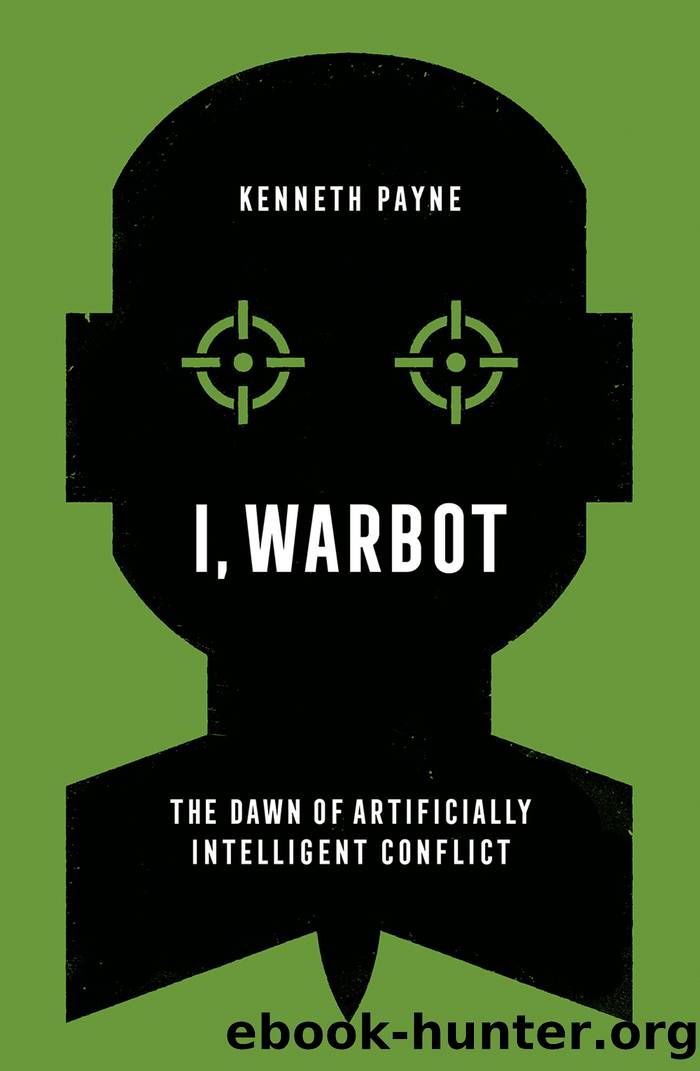I, Warbot by Payne Kenneth;

Author:Payne, Kenneth;
Language: eng
Format: epub
Publisher: Hurst Publishers
Published: 2021-10-15T00:00:00+00:00
War games
And intelligent machines? How would they go about âsensing the truthâ in the real world? Would they too be risk averse when it comes to nuclear escalation? One thing is abundantly clearâthey would do things very differently from Kennedy; by playing the odds, like game theorists, not mind reading like world leaders. And if they injected some randomness into proceedings, then unlike Schellingâs man dancing on the clifftop, they wouldnât be remotely interested in observing the whites of the other personâs eyesâjust on calculating probabilities. If you do this, I do that.
If i-War ever becomes a reality, warbots will decide on escalation. That was, after all, one of the options for DARPAâs Deep Green projectâthe ability not just to shape operational decisions by humans, but to make them itself. Weâll need to think carefully how they go about it. Perhaps now, armed with some insights from human strategy, weâre better placed to understand how intelligent machines might shape warfare.
At the most tactical level, in battle, the mechanics of warbot escalation might not matter all that much, at least beyond those involved in the fight itself. A small armed drone comes under fire, and communicates to the swarm operating nearby, which diverts other drones to suppress its attackers. This is probably what most people have in their minds now, when they think about âkiller robotsââan armed Predator drone. But the pressure of combat could push this sort of autonomy ever upwards. Smaller actionsââcontactsââare knitted into larger engagements; engagements become battles; the battles fought by these tactical units need sequencing. Is this the moment when a human commander can come in âon the loopâ to weigh further escalation, and to be legally and ethically accountable for the consequences of doing so? Perhaps. But if the enemy is content to leave that sort of decision to a more senior commander, the human commander might be defeated by speed, by the machineâs more astute tactical judgment, or by some other advantage of tactical autonomy.
Somewhere between an autonomous tactical drone armed with a shotgun and thermonuclear war there must be a firebreak where human judgment can be brought to bear. Time is critical the closer you are to the action. As we move to the more elevated levels of command there should be more time for human judgment. The problem is that itâs not abundantly clear where that level is, or what factors will shape it. There are huge risks here. Some degree of autonomy and AI is already incorporated in weapons systems that are capable of extremely high levels of violence. At the moment these are predominantly defensive systems, and the autonomy is there largely because the system needs to be inhumanly fast. But that need not always be the case, and the line between offensive and defensive weapons is rather subjective.
And thereâs a further risk: the sorts of weapons that can deliver nuclear weapons are abundantly capable of being deployed with non-nuclear warheads. Until recently the ballistic missile was the most assured way of delivering a nuclear warhead.
Download
This site does not store any files on its server. We only index and link to content provided by other sites. Please contact the content providers to delete copyright contents if any and email us, we'll remove relevant links or contents immediately.
| Anthropology | Archaeology |
| Philosophy | Politics & Government |
| Social Sciences | Sociology |
| Women's Studies |
The Secret History by Donna Tartt(16618)
The Social Justice Warrior Handbook by Lisa De Pasquale(11489)
Thirteen Reasons Why by Jay Asher(7786)
This Is How You Lose Her by Junot Diaz(5768)
Weapons of Math Destruction by Cathy O'Neil(5034)
Zero to One by Peter Thiel(4823)
The Myth of the Strong Leader by Archie Brown(4789)
Promise Me, Dad by Joe Biden(4444)
Stone's Rules by Roger Stone(4415)
Beartown by Fredrik Backman(4413)
How Democracies Die by Steven Levitsky & Daniel Ziblatt(4397)
The Fire Next Time by James Baldwin(4341)
100 Deadly Skills by Clint Emerson(4076)
A Higher Loyalty: Truth, Lies, and Leadership by James Comey(4031)
Rise and Kill First by Ronen Bergman(4012)
The David Icke Guide to the Global Conspiracy (and how to end it) by David Icke(3881)
The Farm by Tom Rob Smith(3871)
Secrecy World by Jake Bernstein(3782)
The Doomsday Machine by Daniel Ellsberg(3730)
